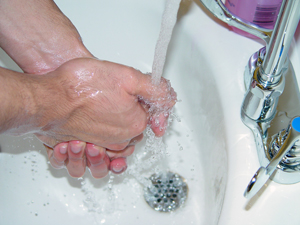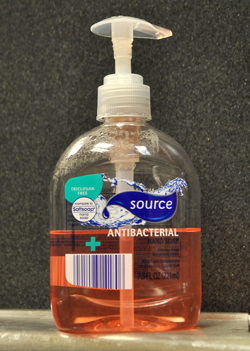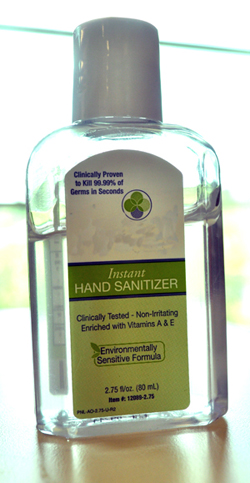Washing Your Hands: The five key steps to avoiding germs and the flu
Return to Heath and Nutrition Agent Articles
 According to the Mayo Clinic, "Hand washing, when done properly, is one of the best ways to avoid getting sick." It's not enough to briefly stick your hands under running water and then dry them.
According to the Mayo Clinic, "Hand washing, when done properly, is one of the best ways to avoid getting sick." It's not enough to briefly stick your hands under running water and then dry them.
Follow these five key steps to properly clean your hands and prevent infection.
- Wet your hands with clean, warm running water and apply soap. Water makes the soap more effective.
- Rub hands together to make a lather. Scrub all surfaces including the wrists, in between fingers, the back of the hand and under the nails.
- Continue rubbing hands for 20 seconds. Need a timer? Imagine singing the alphabet song to yourself. When you get to the line, "Now I know my ABCs" it's time to:
- Rinse hands well under running water.
- Dry your hands using a paper towel or air dryer. It’s important to completely dry your hands. I like to tell my younger students that “germs love wet stuff”, especially wet hands. If possible, use your paper towel to turn off the faucet and open the door.
Always wash your hands:
- Before preparing or eating food.
- After going to the bathroom.
- After changing diapers or cleaning up a child who has gone to the bathroom.
- Before and after tending to someone who is sick.
- After blowing your nose, coughing or sneezing.
- After handling an animal or animal waste.
- After handling garbage.
- Before and after treating a cut or wound.
But remember to also wash your hands:
- After shopping.
- After shaking hands.
- After using the pen at the bank or the grocery store.
What about the recent reports on antibacterial soaps? Many consumers, myself included, believed that soaps labeled “antibacterial” would be more effective with its pathogen-fighting chemical additives than just plain regular soap. But recent reports from the FDA show this isn’t true. In fact, some studies show that consumers may be inclined to overuse these products thus leading to potential negative health effects. Washing hands with plain soap and water is all that’s needed and recommended by health experts.
Many consumers, myself included, believed that soaps labeled “antibacterial” would be more effective with its pathogen-fighting chemical additives than just plain regular soap. But recent reports from the FDA show this isn’t true. In fact, some studies show that consumers may be inclined to overuse these products thus leading to potential negative health effects. Washing hands with plain soap and water is all that’s needed and recommended by health experts.
What about hand sanitizers?
One of my pet peeves is walking into an elementary school classroom and seeing a big bottle of hand sanitizer on the teacher’s desk and knowing that many teachers opt to use hand sanitizers instead of herding their class to the restrooms to wash hands. This is understandable since we all know how unruly elementary school children can be. And squirting a blob of hand sanitizer onto fidgety hands is a lot easier than trying to manage a group of fidgety bodies going to and from restrooms.
Understanding aside, however, elementary classrooms are some of the germiest places on the planet, and hand sanitizers offer little defense to the disease-laden-microorganisms in that environment. Many of us are fooled by the label on the front of the bottle claiming that sanitizers kill 99.9% bacteria; that’s a lot of dead microbes! But, the trouble is, not all microorganisms are bacteria. Some microorganisms are viruses, like the flu virus. And, the best way to effectively get the flu virus off your hands is to wash them with soap and water. Also, just like antibacterial soaps, hand sanitizers have a tendency to be overused thus reducing their effectiveness and also increasing the potential health risk to the user; not all bacteria are bad. A common question I’m asked is, “Are hand sanitizers better than nothing?” If you do not have access to clean running water and soap, then yes, hand sanitizers can be a good backup if used correctly. The most effective sanitizers contain an alcohol concentration between 60 – 95%. Non-alcohol-based hand sanitizers, while gentler and less-drying to skin, do not kill as many microorganisms and could cause germs to develop a resistance to the sanitizer itself. Another thing to keep in mind when using sanitizers is that you need a fairly large amount for it to work successfully. Think puddle as opposed to dollop when squirting it into your palm. Then, you’ll want to incorporate it into your skin until you can’t feel it anymore, which may take up to a minute. This is another reason why school kids and sanitizer don’t mix well; many kids will rub the sanitizer in for a few seconds and then wipe the excess off which not only gets rid of the cleaning agent but also re-contaminates their hands.
A common question I’m asked is, “Are hand sanitizers better than nothing?” If you do not have access to clean running water and soap, then yes, hand sanitizers can be a good backup if used correctly. The most effective sanitizers contain an alcohol concentration between 60 – 95%. Non-alcohol-based hand sanitizers, while gentler and less-drying to skin, do not kill as many microorganisms and could cause germs to develop a resistance to the sanitizer itself. Another thing to keep in mind when using sanitizers is that you need a fairly large amount for it to work successfully. Think puddle as opposed to dollop when squirting it into your palm. Then, you’ll want to incorporate it into your skin until you can’t feel it anymore, which may take up to a minute. This is another reason why school kids and sanitizer don’t mix well; many kids will rub the sanitizer in for a few seconds and then wipe the excess off which not only gets rid of the cleaning agent but also re-contaminates their hands.
The best way to use sanitizers is after you clean the dirt off your hands with soap and water. Sanitizers are just that — sanitizers. They are not "cleanitizers." Studies show that sanitizers are no match compared to the melting properties of warm water and abrasive qualities of soap at removing dirt, oils and germs from the hands. This is why washing is the preferred method by experts for maintaining not only healthy hands but a healthy community. Washing cleans AND sanitizes hands. Commercial hand sanitizers just kick it up a notch.
Back to Agent Articles
